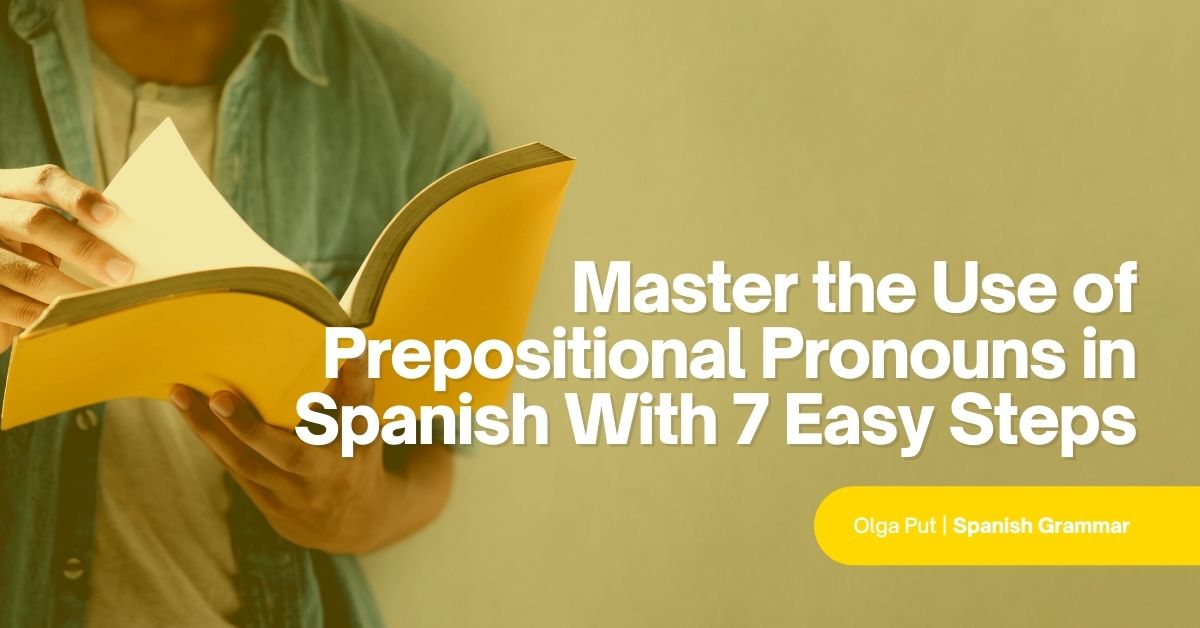
Conducir vs Manejar: What’s the Difference Between These Two Spanish Verbs?
Conducir and manejar are both used interchangeably in Spanish-speaking countries. However, they differ in meaning and use. Conducir and manejar mean “to drive,” among other things. Second-guessing which verb to choose is common. Yet, making the distinction is actually easier than you think! Even native speakers struggle in recognizing the difference. Join me in this blog post where I...Read More
Master the Use of Prepositional Pronouns in Spanish With 7 Easy Steps
Prepositional pronouns in Spanish can be mastered with simple steps. To understand prepositional pronouns in Spanish, I provide you with the definition, forms, and many example sentences. You’ll also learn a few exceptions so that nothing can surprise you in the future. And last but not least, you’ll be able to see how much you’ve learned by taking the quiz at the end of the...Read More
Types of Spanish Words You Shouldn’t Capitalize
Spanish capitalization rules are sometimes surprising. Not all the words that are capitalized in English should be written in uppercase letters in Spanish, and vice versa. Learning capitalization rules is part of learning a new language. Read this article to learn about the capitalization rules in Spanish. In the end, test your knowledge with a pop quiz! Capitalization Rules in...Read More
How to Use Spanish Verbs with Prepositions ‘Con,’ ‘En,’ and ‘Por’
Spanish verbs with prepositions rarely resemble English verbs with prepositions combinations. They often have surprising translations that you would never suspect. To learn about this topic, a list of Spanish verbs with prepositions is not enough. I divided this post into logical sections that are easy to digest. You’ll also see many examples that will help you understand how Spanish...Read More
How to Form the Imperative Mood in Spanish
If you’ve ever taken a Spanish class, you’ve learned the imperative mood in Spanish right off the bat. You hear sentences in Spanish using the imperative mood from the first lesson. For example: Abran sus libros.Open your books. Repite, por favor.Repeat, please. Escuchen con atención.Listen carefully. Read this article to understand the grammar behind these sentences so that you...Read More
Escuchar vs Oír: What’s the Difference Between These Two Spanish Verbs?
Escuchar and oir can be challenging verbs to master for Spanish learners. People tend to use both verbs to reference the art of hearing and listening. Both words are used interchangeably but have different meanings when you use them in practice. Even native speakers tend to confuse them with each other, which makes it difficult for Spanish learners who want to practice their...Read More
What You Should Know About Indirect Objects in Spanish
Indirect objects in Spanish are a key topic to master. Spanish speakers use them in every single conversation. Understanding and knowing how to use indirect objects is essential. Today, let me explain to you what indirect objects in Spanish are and how to use them in a sentence. I promise to give many formulas and examples to make this topic easy to follow. This guide offers an answer...Read More
Venir Conjugation: Free Spanish Lesson and Quiz
If you’re a Spanish learner, you’ve come to the right place for a lesson on venir conjugation! The Spanish verb venir means “to come.” Venir is an irregular, stem-changing -ir verb, similar to seguir. Read this lesson to discover the ins and outs of venir conjugation in the following moods and tenses: Indicative mood (present, past, past imperfect, conditional, and future...Read More
Understanding the Spanish Subjunctive in Noun Clauses
Do you know how to use the subjunctive in noun clauses? It’s actually an easy topic to grasp if you already have a foundation in Spanish grammar. To access a quick but thorough overview of the subjunctive in noun clauses, keep reading! I cover all the grammar elements necessary to master the topic and give you lots of examples of the subjunctive in noun clauses. At...Read More
